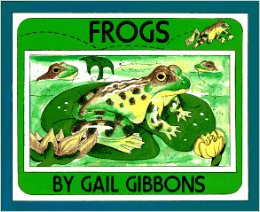 When spring arrives and ponds come alive male frogs can be heard croaking and frog eggs may be seen floating in the water. What better time to introduce young readers to the life cycle of frogs? Gail Gibbon’s book, Frogs, provides that and more. Written for children in kindergarten through second grade, the book describes the life of frogs from egg to adult.
When spring arrives and ponds come alive male frogs can be heard croaking and frog eggs may be seen floating in the water. What better time to introduce young readers to the life cycle of frogs? Gail Gibbon’s book, Frogs, provides that and more. Written for children in kindergarten through second grade, the book describes the life of frogs from egg to adult.
Gibbons combines factual information with illustrative artwork to create a very appealing book. She begins with the frog eggs, the hazards they encounter, and the development of the tadpole within. She explains how they first live in water eating vegetative material and breathing by gills, and slowly lose their tails, develop legs and lungs, and move to the land where they eat insects and worms. The author introduces terms such as amphibian and herpetologist, and explains the term “cold blooded”. She goes on to show the anatomy of a frog, and explain their food getting methods, protective devices, the way they make sounds to attract a mate, their need to hibernate, and the importance of their role in the balance of nature. A two page spread shows the differences between a frog and a toad, and a final page presents interesting facts about frogs. Did you know, for example, that some frogs are big enough to eat mice and rats?
Gibbons presents the information on frogs so that young readers can both understand and enjoy it. The illustrations closely follow the text and faithfully show the processes and features described. Pictures are labeled where needed and difficult words are shown phonetically. Frogs has great appeal for both children and adults and I highly recommend it.
To buy Frogs from Amazon.com click here.